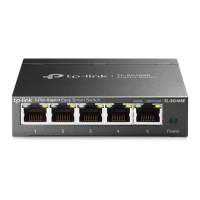87
C VLAN: Displays the ID number of the Customer VL
AN. C VLAN refers to
the VLAN to which the packet received by switch belongs.
Displays the ID number of the Service Provider VLAN.
Displays the Service Provider Priority.
Displays a description to the VLAN Mapping entry.
Operation: Click the Edit
button to modify the settings of the entry and click
the Modify button to apply.
6.8 GVRP
GVRP (GARP VLAN Registration Protocol) is an implementation of GARP (generic attribute
registration protocol). GVRP allows the switch to automatically add or remove the VLANs via
the dynamic VLAN registration information and propagate the local VLAN registration
information to other switches, without having to individually configure each VLAN.
GARP
GARP provides the mechanism to assist the switch members in LAN to deliver, propagate and
register the information among the members. GARP itself does not work as the entity among
the devices. The application complied with GARP is called GARP implementation, and GVRP is
the implementation of GARP. When GARP is implemented on a port of device, the port is called
GARP entity.
The information exchange between GARP entities is completed by messages. GARP defines
the messages into three types: Join, Leave and LeaveAll.
•
Join Message: When a GARP entity expects other switches to register certain attribute
information of its own, it sends out a Join message. And when receiving the Join message
from the other entity or configuring some attributes statically, the device also sends out a
Join message in order to be registered by the other GARP entities.
•
Leave Message: When a GARP entity expects other switches to deregister certain attribute
information of its own, it sends out a Leave message. And when receiving the Leave
message from the other entity or deregistering some attributes statically, the device also
sends out a Leave message.
•
LeaveAll Message: Once a GARP entity starts up, it starts the LeaveAll timer. After the timer
times out, the GARP entity sends out a LeaveAll message. LeaveAll message is to
deregister all the attribute information so as to enable the other GARP entities to re-register
attribute information of their own.
Through message exchange, all the attribute information to be registered can be propagated
to all the switches in the same switched network.
The interval of GARP messages is controlled by timers. GARP defines the following timers:
• Hold Timer: When a GARP entity receives a piece of registration information, it does not
send out a Join message immediately. Instead, to save the bandwidth resources, it starts
the Hold timer, puts all registration information it receives before the timer times out into
one Join message and sends out the message after the timer times out.

